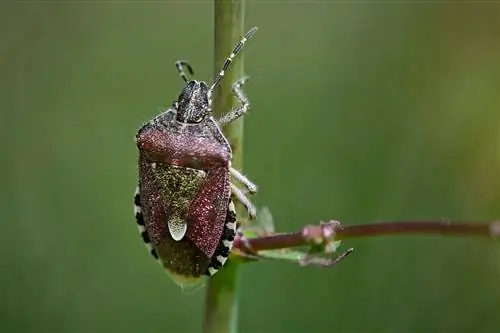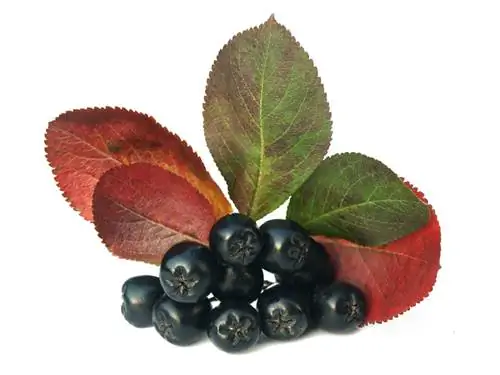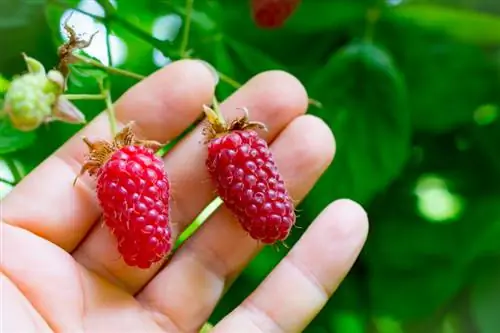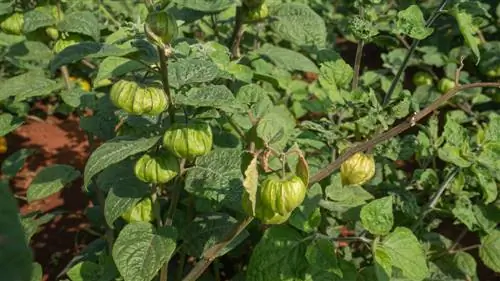- Author admin [email protected].
- Public 2024-01-15 08:07.
- Last modified 2025-01-23 11:22.
Read interesting facts about the loganberry in the commented profile here. Information on origin, growth, fruits and taste. Lots of tips about planting and caring for the Californian berry variety.
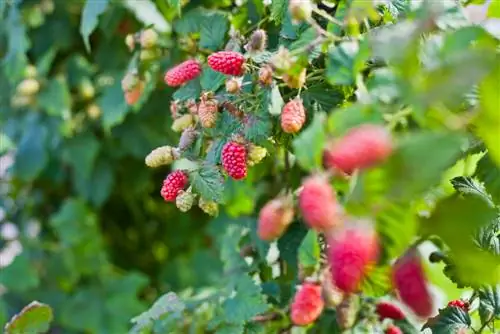
What is the loganberry?
The loganberry (Rubus loganobaccus) is a cross between blackberry and raspberry that originated in California. The berries are elongated, aromatic and have a wine-sour taste. The plant grows as a climbing shrub with a height of up to 5 meters and is self-fertilizing.
Profile
- Scientific name: Rubus loganobaccus
- Origin: America, Garden of James Logan
- Growth type: shrub
- Growth: climbing, deciduous
- Growth height: 300 cm to 500 cm
- Leaf: pinnate, wintergreen
- Flower: five-fold, white
- Fruit: Berry
- Taste: aromatic, wine-sourish
- Harvest time: July and August
- Winter hardiness: hardy
- Use: orchard, container, sweet fruit
Origin
The loganberry is a chance cross between blackberry (Rubus ursinus) and raspberry (Rubus idaeus). The berry variety was created in 1881 in the garden of the Californian judge and passionate amateur gardener James Harvey Logan. As part of tireless experiments, Logan achieved breeding success that was recognized worldwide. The blackberry variety 'Aughinbaugh' and the raspberry variety 'Red Antwerp' were probably actively involved in the hybrid's high-quality genetic makeup.
Growth
The growth of a loganberry is comparable to the native blackberry bush. The following overview summarizes important key data:
- Growth type: Spreading climber (hooks itself to vegetation and climbing aids with spines or thorns).
- Growth habit: upright shrub with numerous, meter-long basal shoots.
- Growth height: 3 m to 5 m
- Growth rate: 100 cm to 500 cm growth per year
- Roots: Shallow roots without runners
The epically long rods are densely covered with straight spines (no thorns) and beautifully feathered, somewhat coarse leaves. In mild regions, the loganberry thrives as a wintergreen shrub that retains its leaves until late winter.
Fruits
Rubus loganobaccus is a self-pollinating berry variety. Pollinated, white-pink cup flowers are hermaphroditic and turn into collective drupes. The aromatic fruits cannot deny their close relationship with raspberries. These characteristics explain the cult status of Californian Loganberry:
- Fruit shape: elongated, cone-shaped
- Fruit size: 2 cm to 4 cm long
- Color: bright red to dark red
- Taste: aromatic, juicy-sour
Freshly harvested loganberries only last for two days when refrigerated. For this reason, you can rarely buy the delicious fruits in the supermarket or at the weekly market. In Germany, the berry variety is primarily grown in hobby gardens.
Video: Looking forward to a refreshing treat - admiring freshly harvested loganberries up close
Harvest time
Just in time for the hot summer, the ripe, elongated loganberries promise refreshing fruit enjoyment. From July to August, the shrub carries its juicy, sour load and invites you to snack he althily. Harvest-ripe fruits are dark red in color from base to tip.
Usage
The list of advantageous properties is long: rapid growth, opaque foliage, picturesque flowers and bright red, tasty fruits characterize the berry variety. That's why loganberries are suitable for decorative and culinary uses. Let the following table inspire you as to how you can take advantage of the many benefits of the successful cross between blackberries and raspberries:
| Cultivation/Cultivation | Consumption/Processing |
|---|---|
| Bucket with climbing aid | Fresh consumption |
| Balcony box with trellis | Jam |
| Bed on the trellis | Jelly |
| South facade with climbing aid | Juice, smoothie |
| Fence greening in the cottage garden | Fruit salad |
| Privacy trellis on the roof garden | Granola ingredient |
| Bee Pasture | Cake topping |
Planting logan berries
The robust loganberry is a hit for the private orchard. The popular berry variety is easy to plant, thrives in almost any location and provides the whole family with tasty fruit enjoyment that cannot be bought on every corner. What you should pay attention to when buying planting material, which site conditions are optimal and how to plant the shrub correctly can be found in the following sections:
Buy Loganberry Seeds
Numerous shopping sources on the Internet offer loganberries as planting material for hobby gardeners. Ideally, you should buy a young plant from a tree nursery or garden center you trust. This has the advantage that you are buying he althy, virus-tested planting material from cultivation in the regional climate. Take a close look at the young loganberry. New, white roots should be visible on the edge of the pot as a sign of he alth and growth.
Extra tip: It's best to buy the loganberry in a double pack. Although the berry variety is self-fertile, crop yield and fruit quality will benefit if you plant at least two specimens.
Location
The modest demands of a loganberry on the location can easily be met in any common hobby garden:
- Sunny to partially shaded without direct sunlight in the afternoon.
- Humoser, loose, permeable garden soil.
- Soil quality preferably sandy-loamy, fresh to moist and without the risk of waterlogging.
As we know from local fruit trees, the loganberry does not thrive in the shade, in acidic or very calcareous soil.
Planting instructions
The best time to plant loganberries is in autumn so that the roots can build up properly over the winter. Beforehand, place the root ball and pot in a bucket of rainwater until no more air bubbles appear. How to plant the berry bush correctly:
- Set up a trellis, trellis or wire frame as a climbing aid.
- Dig a planting pit that is 10 cm larger on each side than the root ball.
- Planting distance is 150 cm to 200 cm.
- Mix the excavated soil with compost and horn shavings, and improve heavy clay soil with sand.
- Unpot water-soaked loganberries.
- Plant the young bush 5 cm to 10 cm deeper than before in the pot for strong, basal new shoot formation.
- Tie shoots at the bottom of the trellis in a fan shape.
Finally, water the freshly planted loganberry generously without causing waterlogging.
Excursus
Superfood Loganberry
Many he althy properties make the loganberry a popular superfood. 100 grams of fresh fruit contains a slim 26 calories. With this amount you can snack on a whopping 35 mg of vitamin C and valuable trace elements such as calcium, potassium and magnesium. Deliciously packaged in a juicy, sour berry flavor, the ingredients ward off free radicals and promote the he alth of radiant, beautiful skin, firm teeth and stable bones.
Care for logan berries
The loganberry is undemanding and easy to care for. Regular watering and fertilization as well as consistent pruning care are the mainstays of the care program. The vigorous raspberry blackberry can be propagated with lowering plants. Essential for care work without injuries is good protection against the nasty thorns in the form of thorn-proof gloves (€17.00 on Amazon), safety glasses, rubber boots and sturdy clothing. Read these important care tips in brief:
Pouring
The loganberry cannot tolerate long periods of drought or waterlogging. Water the shallow rooter when the soil feels dry. Rare, penetrating watering is better than daily watering in small amounts. Allow the water to run directly onto the root disc until the first puddles form as an indication of the beginning of waterlogging. The soil on the root disc should dry thoroughly before the next watering. Rainwater, pond water and normal tap water are equally suitable as irrigation water.
Fertilize
Note three fertilizer applications on the care plan. Fertilize the loganberries with compost in March/April. In June, sprinkle 100 grams of horn meal onto the root slice and water again. Organic potassium fertilization after harvest strengthens winter hardiness. For this purpose, sprinkle the soil with comfrey manure.
Cutting
You can cut the loganberry bush like blackberries. The aromatic fruits form on the two-year-old tendrils. After harvesting, cut off the removed canes at ground level. These cut shoots initially remain on the climbing aid as natural frost protection.
The second stage of pruning care follows in February. Now pull the clippings off the trellis. In addition, thin out the shrub thoroughly by cutting out diseased, stunted, damaged and weak branches. Shorten the side branches of last year's long canes and thus this year's fruit canes to two eyes. You do not cut the long rods themselves, or only if they are too long. It is important to ensure that infected canes are disposed of correctly in the organic waste bin and not in the compost. At the end, tie the best 5 to 6 fruit canes to the trellis in a fan shape.
Propagate
As a cross between raspberries and blackberries, the loganberry is easiest to propagate using planters. In autumn or spring, dig a 10 cm deep furrow next to the mother plant, place a tendril in it and cover the shoot with soil. The offshoot remains connected to the shrub until its own root system has formed. Then cut off the rooted tendril, dig up the root ball and plant the young loganberry in the new location.
Popular varieties
Because the loganberry is so prickly, knowledgeable breeders give troubled hobby gardeners these thornless varieties:
- Thornless Loganberry: Gardener-friendly variety without thorns and with tasty berries from July.
- Loganberry LY654: thornless berry variety with elongated, purple-colored fruits and a sour taste.
- Buckingham Tayberry: Scottish cross between raspberry and blackberry, thornless, easy to care for and particularly hardy.
FAQ
What is the difference between loganberry and tayberry?
Both types of berries are a cross between raspberries and blackberries with tasty, sweet and sour fruits. The hybrids can be distinguished by their growth. The loganberry grows to a height of 5 meters without pruning and forms a dense network of prickly tendrils. With a growth height of 100 to 180 centimeters, the Tayberry remains significantly smaller and thrives either with harmless, delicate spines or without spines. In contrast to the Californian loganberry, the Tayberry comes from Scotland and is considered the hardier berry variety.
Is the loganberry self-pollinating or should you plant a second type of berry?
Basically, the loganberry thrives as a self-fruitful berry variety. The harvest yields from solitary bushes are, of course, significantly lower than from cross-pollination. For this reason it is advisable to add a second variety. Suitable pollinators are all varieties of loganberries, blackberries, raspberries or tayberries. Because loganberries always fruit on two-year-old wood, annual pruning is essential for a rich berry harvest.
Are loganberry bushes hardy?
Yes, a loganberry bush is hardy down to -20° Celsius. This applies to cultivation in beds. However, if you plant the berry variety in a bucket or balcony box with a trellis, we recommend winter protection. Wrap the planter in a winter coat made of fleece or bubble wrap. A wooden foot protects the root ball from frost from below. Ideally, you should push the loganberry in front of a protective house wall.



